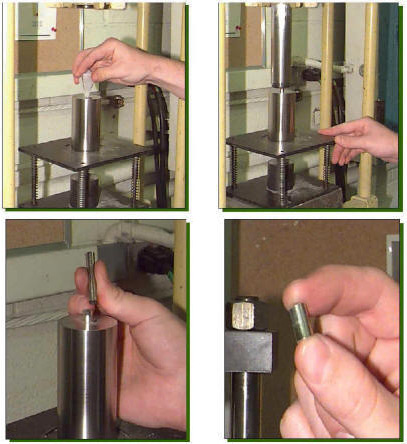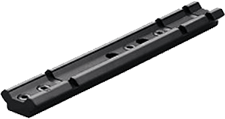Home | Glossary | Resources | Help | Contact Us | Course Map
Archival Notice
This is an archive page that is no longer being updated. It may contain outdated information and links may no longer function as originally intended.
Powdered Metal Technology
Powdered metal technology (PMT) is used more frequently in firearms manufacture. It is a form of casting that does not use molten metal. Finely powdered metal of the desired alloy is placed in a mold with a binder or flux and then heated until the particle boundaries partially melt and the particles fuse together. The advantage is excellent precision. Finished parts are often ready for cosmetic finishing and installation when removed from the mold. The downside is that PMT parts are not as strong as those made by investment casting or forging. PMT tends to be used for the manufacture of low-load parts, such as sight components and triggers.
Extrusion
Extrusion is used to form parts of uniform cross section in long strips that are later cut to final dimension. It is usually applied to nonferrous alloys to create low-load parts.
A bar of material is pressed through a die that is shaped in the negative of the final part. The result is a long part with the desired cross section. Cutting pieces to length makes the parts ready for final forming and finishing. Extrusion is commonly used to make aluminum bases for mounting telescopic sights.
Fine-Forming Operations
Fine forming starts with an intermediate part produced by casting, forging, or stamping. This process prepares the firearms component for final surface finishing and assembly. The majority of these metalworking operations fall under the general subject of machining. Machining covers just about every operation in which a moving tool removes metal to achieve final dimensions. In machining, a sharpened metal tool or abrasive surface refines and reduces the intermediate part to the desired form and dimension. The tool must be harder than the surface it shapes. Machining operations produce heat that, if not controlled, will destroy expensive tooling and potentially damage the intermediate part.
Additional Online Courses
- What Every First Responding Officer Should Know About DNA Evidence
- Collecting DNA Evidence at Property Crime Scenes
- DNA – A Prosecutor’s Practice Notebook
- Crime Scene and DNA Basics
- Laboratory Safety Programs
- DNA Amplification
- Population Genetics and Statistics
- Non-STR DNA Markers: SNPs, Y-STRs, LCN and mtDNA
- Firearms Examiner Training
- Forensic DNA Education for Law Enforcement Decisionmakers
- What Every Investigator and Evidence Technician Should Know About DNA Evidence
- Principles of Forensic DNA for Officers of the Court
- Law 101: Legal Guide for the Forensic Expert
- Laboratory Orientation and Testing of Body Fluids and Tissues
- DNA Extraction and Quantitation
- STR Data Analysis and Interpretation
- Communication Skills, Report Writing, and Courtroom Testimony
- Español for Law Enforcement
- Amplified DNA Product Separation for Forensic Analysts



